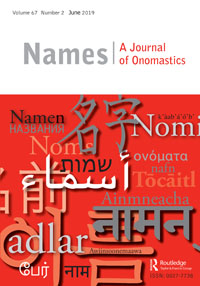Published 2019-04-03
Keywords
- nicknames,
- bynames,
- anthroponymics,
- cognomina,
- Old Norse
- terminology,
- medieval names ...More
Copyright (c) 2019 American Name Society

This work is licensed under a Creative Commons Attribution 4.0 International License.
Abstract
There are place names all around the world formed by a combination of two elements, a specific and a generic, both of which refer to the same geographic feature type. A typical pattern is for an indigenous generic functioning as a specific to precede a matching introduced generic. For example: Ohio River < Iroquoian Ohio ‘Great River’?+?River; and Lake Rotorua < M?ori roto ‘lake’?+?rua ‘two/second’ (‘Second Lake’)?+?Lake. Such toponyms, though not overall numerous, nevertheless occur often enough to warrant being recognized as a distinct class of place names. The literature provides no adequate or consistent term for this pattern: the various attempts clash with each other, and all fail to address the concept effectively. This article aims to address this situation.
References
- Borgmann, Dmitri A. 1973. “An Onomastic Study (Part 2).” Word Ways 6. no. 3: 176–180. Accessed September 29, 2017. http://digitalcommons.butler.edu/wordways/vol6/iss3/13
- Cabré, M. Teresa. 1999. Terminology: Theory, Methods and Applications. Amsterdam: John Benjamins B.V.
- Committee for Geographical Names in Australasia. 1996. Glossary of Generic Terms, Version 1.0. Commonwealth of Australia: Intergovernmental Committee on Surveying and Mapping. Accessed October 05, 2017. www.icsm.gov.au/cgna/glossary_pnames.pdf
- Crowley, Terry. 1997. An Introduction to Historical Linguistics. 3rd ed. Auckland: Oxford University Press.
- Downing, Laura. 2015a. “What is Reduplication? Typology and Analysis, Part 1/2: The Typology of Reduplication.” Language and Linguistics Compass 9. no. 12: 502–515.
- Downing, Laura. 2015b. “What is Reduplication? Typology and Analysis, Part 2/2: The Analysis of Reduplication.” Language and Linguistics Compass 9. no. 12: 516–528.
- Geographical Names Board of Canada. 2011. Principles and Procedures for Geographical Naming. Ottawa: Natural Resources Canada. Accessed September 29, 2017. www.nrcan.gc.ca/sites/www.nrcan.gc.ca/files/earthsciences/pdf/gnames/GNBC_english_accessible.pdf
- Grant, Jeff. 2008. “Accidental Tautonyms.” Word Ways 41. no. 4: 293–296. Accessed October 05, 2017. http://digitalcommons.butler.edu/wordways/vol41/iss4/15
- Hartmann, Reinhard R. K., and Gregory James. 1998. Dictionary of Lexicography. London: Routledge.
- Inkelas, Sharon and Cheryl Zoll. 2005. Reduplication: Doubling in Morphology. Cambridge University Press.
- Inkelas, Sharon. 2008. “The Dual Theory of Reduplication.” Linguistics 46. no. 2: 351–401.
- International Council of Onomastic Sciences. 2012. List of Key Onomastic Terms. Accessed September 29, 2017. http://www.icosweb.net/index.php/terminology.html
- Kadmon, Naftali, ed. 2000a. Glossary of Toponymic Terminology. Version 4, 1 February, Part 1: English. UNGEGN. Accessed September 29, 2017. http://www.ngi.be/NL/glossary/glossang-inf.htm
- Kadmon, Naftali. 2000b. Toponymy: The Lore, Laws and Language of Geographical Names. New York: Vantage Press.
- Landau, Sidney I. 2001. Dictionaries: The Art and Craft of Lexicography. 2nd ed. Cambridge: Cambridge University Press.
- Marantz, Alec. 1982. “Re Reduplication.” Linguistic Inquiry 13. no. 3: 435–482.
- Mattes, Veronika. 2007. “Types of Reduplication: A Case Study of Bikol.” PhD diss., Karl-Franzens-Universität, Graz. Accessed October 05, 2017. http://reduplication.uni-graz.at/texte/Dissertation_gesamt.pdf
- Nash, David. 2008. “Examining the Name Element/Feature Type Cowal.” Unpublished paper presented to ANPS/CGNA workshop, Rydges Hotel, Wollongong, Australia, 11 October.
- Nicolaisen, Wilhelm F. H. 1975. “Place-Names in Bilingual Communities.” Names 23. no. 3: 167–174.
- Nuessel, Frank. 1992. The Study of Names: A Guide to the Principles and Topics. Westport (CT): Greenwood Press.
- Oxford English Dictionary on Historical Principles. 1989. London: Oxford University Press.
- Puder, Jim. 2009. “More Accidental Tautonyms.” Word Ways 42. no. 3: 174–180. Accessed October 05, 2017. http://digitalcommons.butler.edu/wordways/vol42/iss3/9
- Room, Adrian. 1996. An Alphabetical Guide to the Language of Name Studies. London: The Scarecrow Press Inc.
- Sanders, Berit. 2016. “Names and Language Contact.” In The Oxford Handbook of Names and Naming, edited by Carol Hough, 540–553. Oxford: Oxford University Press.
- Tent, Jan. 2001. “A Profile of the Fiji English Lexis.” English World-Wide 22. no. 2: 211–247.
- U.S. Board on Geographic Names. 2016. Principles, Policies, and Procedures / Domestic Geographic Names. Version 1.0. Reston (Virginia): Domestic Names Committee. Accessed October 05, 2017. https://geonames.usgs.gov/docs/DNC_PPP_DEC_2016_V.1.0.pdf

